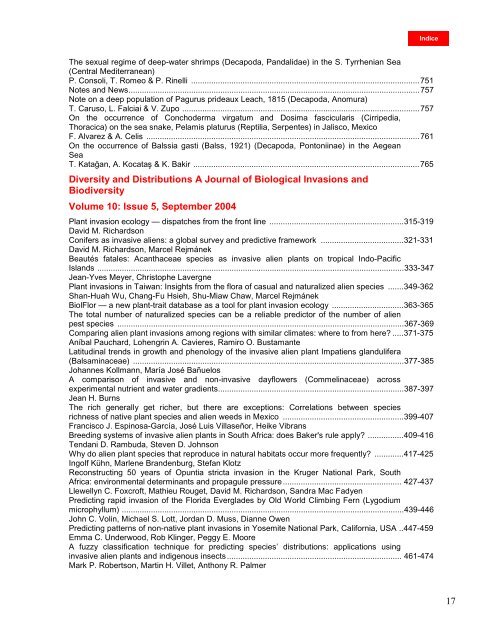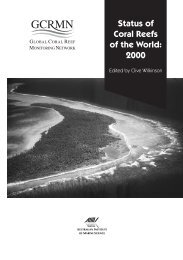BOLETIN185-OCTUBRE DE 2004 - Instituto de Ciencias del Mar y ...
BOLETIN185-OCTUBRE DE 2004 - Instituto de Ciencias del Mar y ...
BOLETIN185-OCTUBRE DE 2004 - Instituto de Ciencias del Mar y ...
- No tags were found...
You also want an ePaper? Increase the reach of your titles
YUMPU automatically turns print PDFs into web optimized ePapers that Google loves.
The sexual regime of <strong>de</strong>ep-water shrimps (Decapoda, Pandalidae) in the S. Tyrrhenian Sea<br />
(Central Mediterranean)<br />
P. Consoli, T. Romeo & P. Rinelli ......................................................................................................751<br />
Notes and News..................................................................................................................................757<br />
Note on a <strong>de</strong>ep population of Pagurus pri<strong>de</strong>aux Leach, 1815 (Decapoda, Anomura)<br />
T. Caruso, L. Falciai & V. Zupo ..........................................................................................................757<br />
On the occurrence of Concho<strong>de</strong>rma virgatum and Dosima fascicularis (Cirripedia,<br />
Thoracica) on the sea snake, Pelamis platurus (Reptilia, Serpentes) in Jalisco, Mexico<br />
F. Alvarez & A. Celis ..........................................................................................................................761<br />
On the occurrence of Balssia gasti (Balss, 1921) (Decapoda, Pontoniinae) in the Aegean<br />
Sea<br />
T. Katağan, A. Kocataş & K. Bakir .....................................................................................................765<br />
Diversity and Distributions A Journal of Biological Invasions and<br />
Biodiversity<br />
Volume 10: Issue 5, September <strong>2004</strong><br />
Plant invasion ecology — dispatches from the front line ............................................................315-319<br />
David M. Richardson<br />
Conifers as invasive aliens: a global survey and predictive framework .....................................321-331<br />
David M. Richardson, <strong>Mar</strong>cel Rejmánek<br />
Beautés fatales: Acanthaceae species as invasive alien plants on tropical Indo-Pacific<br />
Islands .........................................................................................................................................333-347<br />
Jean-Yves Meyer, Christophe Lavergne<br />
Plant invasions in Taiwan: Insights from the flora of casual and naturalized alien species .......349-362<br />
Shan-Huah Wu, Chang-Fu Hsieh, Shu-Miaw Chaw, <strong>Mar</strong>cel Rejmánek<br />
BiolFlor — a new plant-trait database as a tool for plant invasion ecology ................................363-365<br />
The total number of naturalized species can be a reliable predictor of the number of alien<br />
pest species ................................................................................................................................367-369<br />
Comparing alien plant invasions among regions with similar climates: where to from here?.....371-375<br />
Aníbal Pauchard, Lohengrin A. Cavieres, Ramiro O. Bustamante<br />
Latitudinal trends in growth and phenology of the invasive alien plant Impatiens glandulifera<br />
(Balsaminaceae) .........................................................................................................................377-385<br />
Johannes Kollmann, <strong>Mar</strong>ía José Bañuelos<br />
A comparison of invasive and non-invasive dayflowers (Commelinaceae) across<br />
experimental nutrient and water gradients...................................................................................387-397<br />
Jean H. Burns<br />
The rich generally get richer, but there are exceptions: Correlations between species<br />
richness of native plant species and alien weeds in Mexico ......................................................399-407<br />
Francisco J. Espinosa-García, José Luis Villaseñor, Heike Vibrans<br />
Breeding systems of invasive alien plants in South Africa: does Baker's rule apply? ................409-416<br />
Tendani D. Rambuda, Steven D. Johnson<br />
Why do alien plant species that reproduce in natural habitats occur more frequently? .............417-425<br />
Ingolf Kühn, <strong>Mar</strong>lene Bran<strong>de</strong>nburg, Stefan Klotz<br />
Reconstructing 50 years of Opuntia stricta invasion in the Kruger National Park, South<br />
Africa: environmental <strong>de</strong>terminants and propagule pressure..................................................... 427-437<br />
Llewellyn C. Foxcroft, Mathieu Rouget, David M. Richardson, Sandra Mac Fadyen<br />
Predicting rapid invasion of the Florida Evergla<strong>de</strong>s by Old World Climbing Fern (Lygodium<br />
microphyllum) ..............................................................................................................................439-446<br />
John C. Volin, Michael S. Lott, Jordan D. Muss, Dianne Owen<br />
Predicting patterns of non-native plant invasions in Yosemite National Park, California, USA ..447-459<br />
Emma C. Un<strong>de</strong>rwood, Rob Klinger, Peggy E. Moore<br />
A fuzzy classification technique for predicting species’ distributions: applications using<br />
invasive alien plants and indigenous insects.............................................................................. 461-474<br />
<strong>Mar</strong>k P. Robertson, <strong>Mar</strong>tin H. Villet, Anthony R. Palmer<br />
17

















